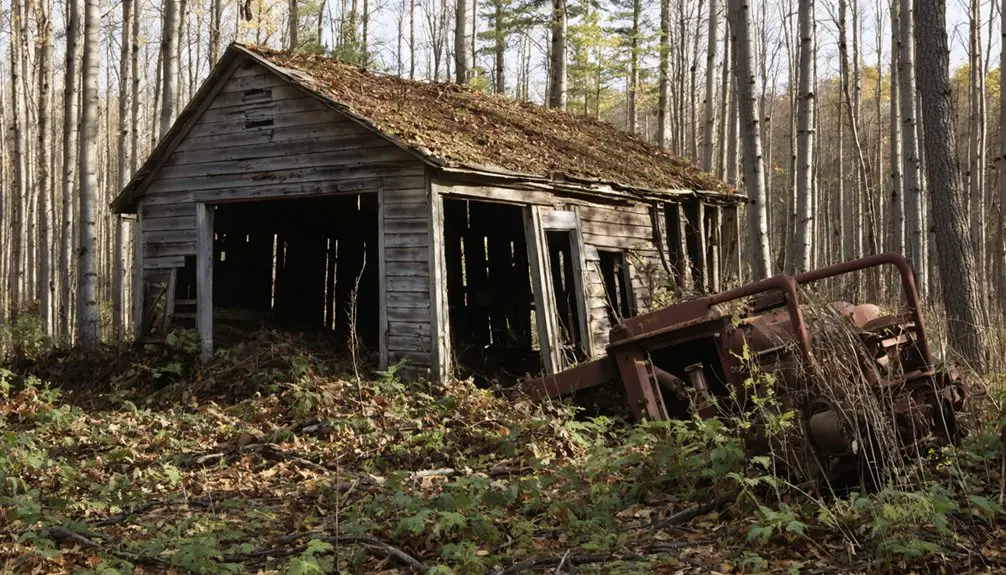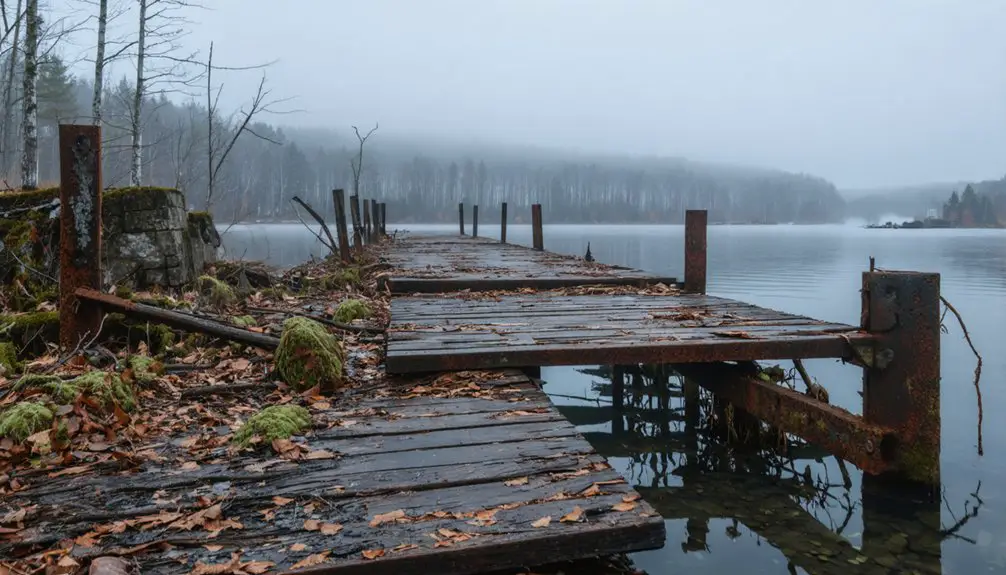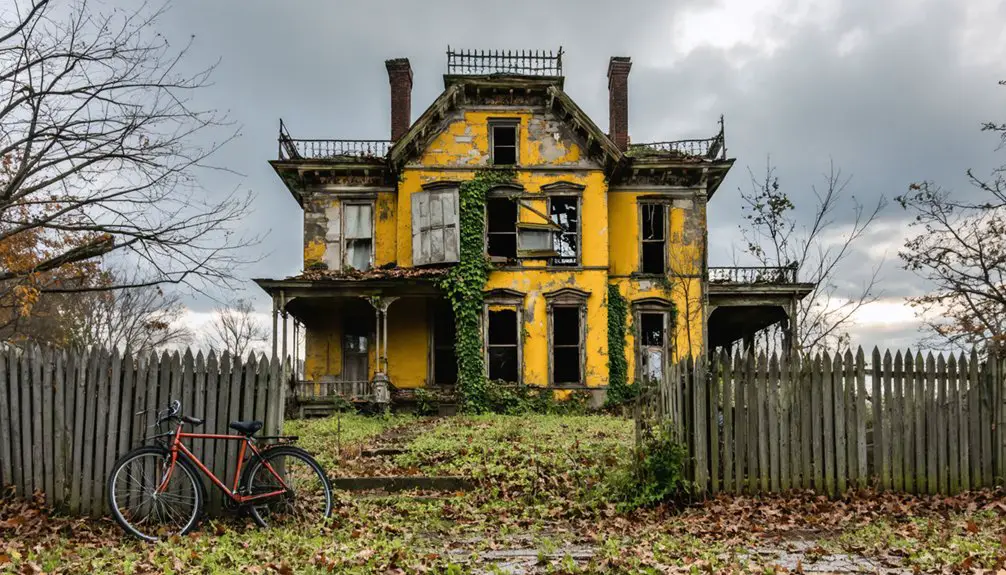You’ll find Happy Valley ghost town within Oswego County’s Happy Valley Wildlife Management Area, where a thriving 1850s agricultural settlement once stood. Originally named Fraser, the community flourished with hop growing before changing to dairy and muck farming. The Great Depression, along with local legends of a witch’s curse and “Black Fever,” led to its abandonment by the 1930s. Today, you can explore stone foundations, a historic cemetery, and weathered ruins that whisper tales of this lost community.
Key Takeaways
- Happy Valley was an 1850s agricultural settlement in Oswego County that became abandoned during the Great Depression due to economic hardship.
- The area transformed from hop growing to dairy and muck farming before its decline, with the post office closing in 1902.
- Local folklore attributes the town’s demise to a witch’s curse called “Black Fever” that allegedly caused deaths and crop failures.
- Physical remnants include stone foundations, weathered wells, cemetery markers, and the ruins of an 1867 schoolhouse.
- The site is now part of the Happy Valley Wildlife Management Area, accessible through unimproved dirt roads with minimal signage.
The Rise and Fall of a Farming Community
While many farming communities sprouted across New York State in the 1800s, Happy Valley emerged in 1850 as a distinctive agricultural settlement in Oswego County. Originally named Fraser, the community demonstrated remarkable agricultural innovation as hop growers from the Mohawk Valley established the first farms. The transformation of worthless swampland into productive farmland was achieved through the efforts of immigrant families who cleared and drained the area.
You’ll find that these pioneers built essential infrastructure, including a school in 1867 and a post office in 1892.
The community’s resilience showed in its adaptation from hop growing to dairy farming in the late 19th century, followed by intensive muck farming. The area’s rich black soil proved ideal for growing onions, celery, and lettuce crops. Despite early success, Happy Valley couldn’t survive the combined pressures of the Great Depression and poor harvests.
Legends of the Cursed Valley
You’ll find one of Happy Valley’s most chilling legends in the tale of a witch who lived on the community’s outskirts and cast a devastating curse after being wronged by a local resident.
Her curse allegedly brought forth a mysterious “Black Fever” that contaminated water sources, killed crops, and decimated the population.
While some versions of the story emphasize supernatural elements, others suggest the town’s demise stemmed from an actual disease outbreak, creating an enduring mystery that blends historical fact with haunting folklore. The area’s transformation into the wildlife management area in 1939 has only deepened its mystique, leaving the truth behind these legends largely unexplored. Much like the ghost of George Fikes at Fort Ontario, these local stories have become deeply woven into Oswego County’s supernatural history.
Witch’s Fatal Curse
Among the most chilling tales of Happy Valley’s demise stands the legend of the Witch’s Fatal Curse, a supernatural affliction that allegedly devastated the 19th-century settlement.
The witchcraft origins trace back to a mysterious woman who lived on the valley’s outskirts, initially helping villagers with remedies and advice. As the community prospered, you’d find her increasingly ostracized and feared. Similar to the legendary Black Hannah of Buffalo, she was both revered and feared for her healing abilities. Her deep emotional turmoil from rejection transformed her healing magic into a weapon of vengeance.
After enduring mounting disrespect and betrayal from residents, she released what locals called the “Black Fever.” The curse brought death to inhabitants, destroyed crops, and poisoned water sources.
You’ll discover that despite attempts to break the hex through graveside rituals and collective apologies, the curse’s grip never loosened.
The valley’s abandonment stands as a stark reminder of the legend’s lasting impact.
Black Fever Mystery
The notorious Black Fever stands at the heart of Happy Valley‘s supernatural folklore, intertwining with the witch’s curse that supposedly doomed the settlement.
You’ll find varying accounts of this mysterious plague, which allegedly contaminated the local water supply during the late 19th or early 20th century. Local folklore suggests the fever emerged from a witch’s curse, devastating both the population and crops.
While no medical records confirm the outbreak’s existence, the Black Fever’s impact on Happy Valley was reportedly severe enough to drive residents away, contributing to the hamlet’s abandonment and the post office’s closure in 1902. The area now contains abandoned building remains that serve as silent witnesses to this dark chapter in local history.
Today, the legend persists as a haunting reminder of the community’s decline, enthralling explorers and paranormal enthusiasts who venture into this Oswego County ghost town. Local historians attribute the town’s actual demise to economic hardships, particularly during the Great Depression era.
The Great Depression’s Impact
During the devastating economic collapse of the Great Depression, Happy Valley experienced catastrophic decline as widespread foreclosures, crop failures, and mass exodus devastated its agricultural community. The land would later become part of the 8,956 acre wildlife preserve.
Happy Valley’s agricultural dream crumbled under the Great Depression’s weight, as farms failed and families fled their once-prosperous community.
The economic hardship transformed this once-thriving farming settlement into a ghost town by the late 1930s, leading to community decline that proved insurmountable. The Roosevelt administration sent skilled photographers to document families living in remodeled chicken houses as they struggled to survive.
- You’d have witnessed families abandoning their homes and farms, seeking work in urban centers.
- You’d have seen the shuttering of crucial institutions, including the local school that had operated since 1867.
- You’d have noticed dairy farms failing as poor crop yields and soil exhaustion took their toll.
- You’d have observed the land’s shift to state ownership in 1939, as the New York DEC established the Happy Valley Wildlife Management Area.
Ghost Stories and Supernatural Tales
Mysterious tales and unexplained phenomena have transformed Happy Valley into one of Oswego County’s most notorious supernatural destinations.
You’ll hear stories of a vengeful Witch who cursed the town, releasing a devastating “Black Fever” that led to its abandonment. The local cemetery, now maintained by Albion, harbors tales of ghostly encounters with a one-armed Civil War soldier wearing a hook – a story backed by authentic military burials on site.
While residents from neighboring Williamstown and Albion avoid the area after dark, you’ll find younger thrill-seekers drawn to these haunted grounds.
The supernatural phenomena reported here – from unexplained lights to shadowy apparitions – connect to broader haunting traditions throughout Oswego County, creating a rich tapestry of regional ghost lore.
Exploring the Remains Today
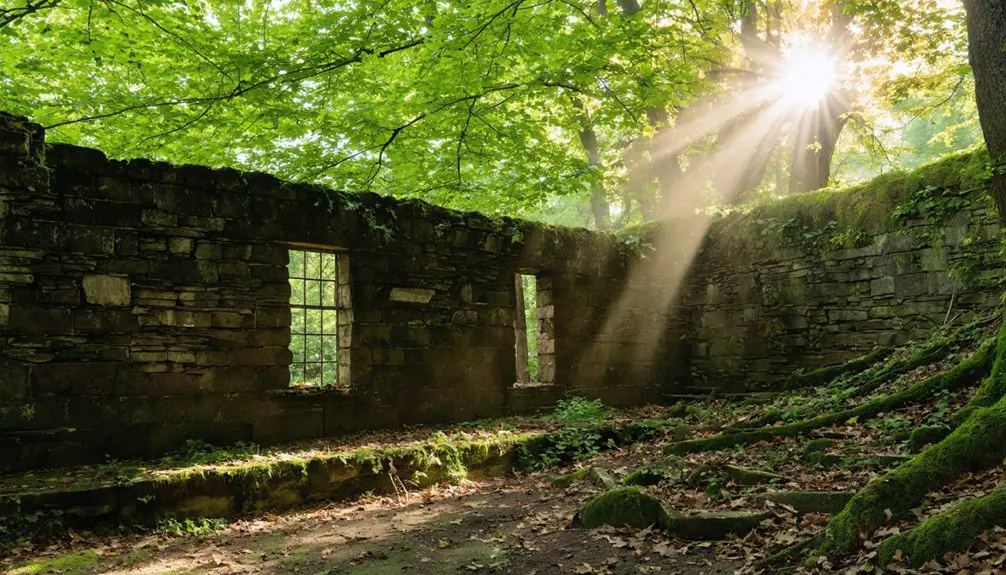
If you’re planning to explore Happy Valley’s remains today, you’ll find scattered stone foundations, old wells, and weathered walls amid dense pine forests and marshlands.
You’ll need to navigate unmarked dirt roads and challenging terrain, as formal trails and GPS coverage are limited throughout the wildlife management area.
Summer visits require extra preparation due to biting insects, while winter exploration offers better visibility of the physical remnants, though you should always exercise caution given the site’s natural hazards and lack of maintained infrastructure.
Physical Remnants Still Standing
Today, visitors to Happy Valley Wildlife Management Area can explore substantial physical remnants of the abandoned settlement, with stone walls, farmhouse foundations, and weathered wells scattered throughout the forested landscape.
You’ll discover stone foundations marking former homesteads and burial markers in the well-maintained cemetery, where Civil War soldiers rest eternally.
- Stand before charred ruins of the old schoolhouse, a haunting reminder of the fire that contributed to the town’s decline
- Walk ancient property boundaries defined by weathered stone walls that snake through the woods
- Visit the historic cemetery where a one-armed Civil War veteran with a hook lies buried
- Explore crumbling wells that once supplied water to Happy Valley’s pioneering families
Reaching Happy Valley’s remnants requires careful navigation through the Happy Valley Wildlife Management Area in Oswego County, New York.
You’ll need to follow unimproved dirt access routes designed for game management, as no paved roads lead directly to the ghost town site. When planning your visit, bring detailed maps or GPS devices, as signage is minimal throughout the area.
The primary navigation tips include preparing for marshy terrain and dense pine forests that can obscure ruins and landmarks.
You’ll want to stick to designated trails and roads, especially after rainfall when conditions deteriorate quickly. While you don’t need special permits for basic exploration, you must follow state regulations protecting the area’s natural and historical resources.
Remember to pack essential supplies, as you’ll be visiting a remote location with limited facilities and cellular reception.
Seasonal Conditions To Consider
When exploring Happy Valley’s remnants throughout the year, you’ll encounter dramatically different conditions that shape both accessibility and safety. Your terrain navigation skills must adapt to Oswego County’s seasonal challenges, from snow-covered trails in winter to marshy lowlands during spring thaw. Weather preparedness becomes essential as conditions can change rapidly in this remote ghost town.
- Winter’s deep snow transforms access, making some areas more approachable but requiring careful navigation around ice-covered stone foundations.
- Spring and summer bring dense undergrowth and biting insects in the marshy terrain, demanding protective clothing and repellent.
- Autumn’s fallen leaves obscure remnants and create slippery conditions on unimproved dirt roads.
- Short winter daylight limits exploration time, while summer offers extended hours but increased wildlife activity.
Wildlife Management Area Transformation
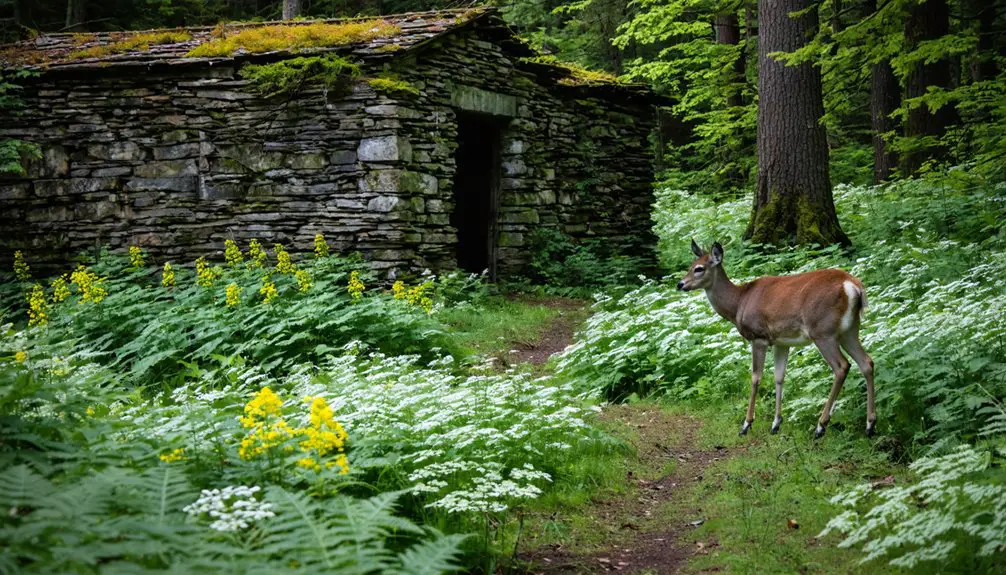
The transformation of Happy Valley into a wildlife management area began in earnest during the late 1930s, as the Works Project Administration and Civilian Conservation Corps launched extensive conifer planting initiatives across the former farmland.
You’ll find this habitat restoration effort laid the groundwork for today’s diverse 8,900-acre preserve in eastern Oswego County.
The area’s evolution continued with the construction of three deep-water impoundments – Mosher, Whitney, and Long Ponds – creating essential wetland habitats.
When the Conservation Department acquired the land in 1961, they established a thorough management approach that’s still in place today.
The mixture of northern hardwoods, planted conifers, and varied successional fields now supports remarkable wildlife diversity, while offering you year-round recreational opportunities in this Lake Ontario-influenced landscape.
Cemetery Secrets and Civil War Connections
Nestled within the Town of Scriba in Oswego County, Happy Valley Cemetery serves as a poignant chronicle of 19th and early 20th-century rural life.
You’ll find cemetery symbolism throughout the grounds, from weathered tombstones adorned with religious motifs to distinctive military emblems marking Civil War veterans’ final resting places.
- Aged gravestones reveal intimate family histories through detailed epitaphs, preserving the legacy of Happy Valley’s earliest settlers.
- Veterans’ memorials feature proud displays of ranks and regiments from New York State’s Civil War contributions.
- Local historical societies maintain digital records of grave transcriptions, making your genealogical research accessible.
- Cemetery artifacts showcase period-specific burial customs, from ornate Victorian symbolism to simpler rural markers.
You can access these historical treasures through various databases, including Find a Grave and USGenWeb archives.
Guided Tours and Local Tourism
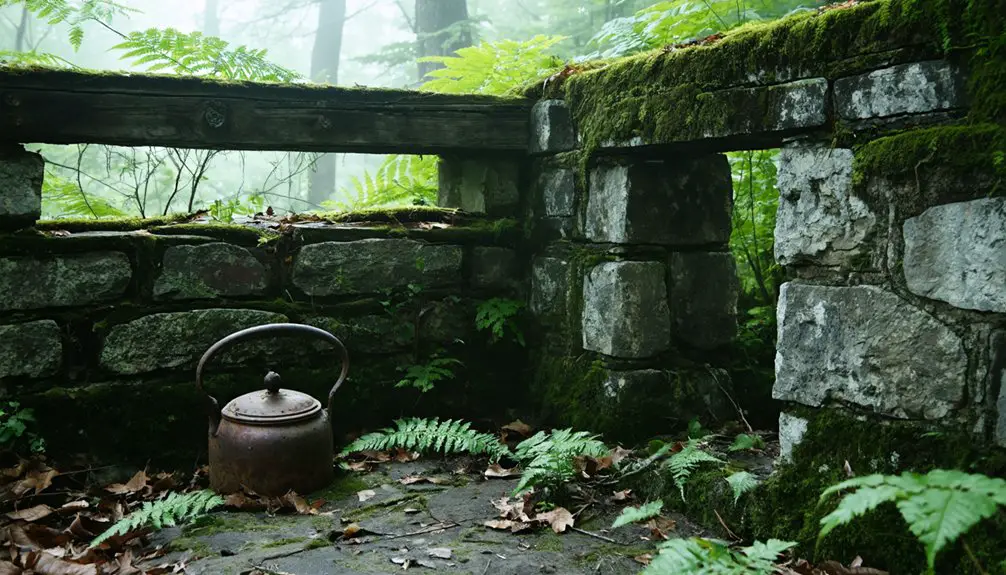
Despite lacking formal guided tours, Happy Valley ghost town offers unique self-guided exploration opportunities within its 5,000-acre Wildlife Management Area off Route 104 in Oswego County.
Discover the untamed ruins of Happy Valley ghost town, nestled within a vast wilderness preserve in upstate New York.
You’ll find the site best accessible during spring through fall, when local roads aren’t impeded by winter snow.
While organized paranormal tours focus mainly on Oswego city’s haunted locations like Fort Ontario, you can arrange private group investigations that include Happy Valley upon request.
The site’s tourism challenges stem from limited infrastructure – there’s no visitor center or interpretive signage.
However, you’re free to explore the hiking trails, discover old foundations, stone walls, and a charred schoolhouse site at your own pace.
Remember to come prepared, as there’s no on-site supervision or emergency services.
Historical Preservation Efforts
While Happy Valley’s remnants lie within a government-owned Wildlife Management Area, preservation efforts remain minimal and largely community-driven. The area’s conversion to a game reserve during the Great Depression has left preservation challenges unaddressed, with natural decay taking its toll on remaining foundations and stone walls.
- The town of Albion maintains the historic cemetery, preserving Civil War soldier burial sites.
- Local historians document oral histories and urban legends, keeping cultural memory alive.
- Volunteer groups occasionally clear brush from visible foundations despite difficult terrain.
- Regional archives preserve historic documents and photographic records of the settlement.
Community engagement faces obstacles including marshy terrain, dense pine forests, and seasonal weather impacts. The Wildlife Management Area’s focus on habitat preservation restricts construction or restoration, leaving Happy Valley’s physical remnants to slowly fade into the landscape.
Frequently Asked Questions
Are There Any Dangerous Animals or Predators in Happy Valley Today?
You’ll find black bears, coyotes, bobcats, and fishers in Happy Valley’s wilderness, but they rarely threaten humans. Practice wildlife safety and predator awareness while exploring these 8,956 acres.
Is Camping Allowed Within the Happy Valley Wildlife Management Area?
You’ll need a permit for primitive camping in Happy Valley WMA, following strict wildlife conservation regulations. You can’t use motorized vehicles or store gear overnight, keeping nature’s freedom intact.
What Are the Best Months or Seasons to Visit Happy Valley?
You’ll find the best activities from late spring through early fall (May-October), when trails are accessible and seasonal events like bird migrations, wildlife viewing, and fall foliage are at their peak.
How Far Is Happy Valley From the Nearest Populated Town?
You’ll find Williamstown, the nearest populated community, just a few miles from Happy Valley. While Syracuse is about 15-20 miles south, Williamstown serves as your closest access point to explore.
Are Metal Detectors or Archaeological Exploration Permitted in the Area?
Like a protective mother bear guarding her cubs, strict metal detecting regulations shield this land. You’ll need special archaeological permits, and they’re rarely granted. Standard WMA rules prohibit soil disturbance and artifact removal.
References
- https://wibx950.com/exploring-the-happy-valley-ghost-town-near-syracuse-the-haunts-and-legends-of-new-york-2/
- https://michaelkleen.com/2017/07/24/happy-valley-ghost-town-cemeteries/
- https://www.youtube.com/watch?v=sIUvSWwaeKo
- https://hauntedhistorytrail.com/explore/haunted-oswego-tour
- https://www.newyorkhauntedhouses.com/real-haunt/happy-valley-wma.html
- https://oswegocountytoday.com/stories-from-oswego-countys-past/a-bit-of-local-farm-history/
- http://www.jimfarfaglia.com/blog/2020/8/21/the-muck-farms-of-oswego-county
- https://www.youtube.com/watch?v=h3nFVmHz_Tk
- https://s30428.pcdn.co/wp-content/uploads/sites/2/2019/09/21st_Century_Farms-Oswego_Cty_NY_1.pdf
- https://www.youtube.com/watch?v=mSDf4WCZghs
